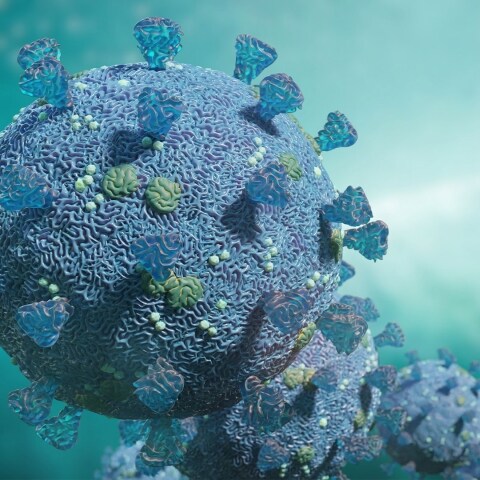 The average human body holds more bacterial cells than human cells, and these microbial symbionts are important to numerous bodily functions. The most famous is the gut microbiome, a diverse assortment of microbes that live in the human intestine and contribute to intestinal health. Research has long suggested that the gut microbiome has a larger role in human biology, and the spread of SARS-CoV-2 virus has provided some tantalizing clues. In particular, several scientific papers have now demonstrated a correlation between SARS-CoV-2 infection severity and gut microbiome diversity.
The average human body holds more bacterial cells than human cells, and these microbial symbionts are important to numerous bodily functions. The most famous is the gut microbiome, a diverse assortment of microbes that live in the human intestine and contribute to intestinal health. Research has long suggested that the gut microbiome has a larger role in human biology, and the spread of SARS-CoV-2 virus has provided some tantalizing clues. In particular, several scientific papers have now demonstrated a correlation between SARS-CoV-2 infection severity and gut microbiome diversity.
Intestinal bacteria are a community that can recognize and interfere with interloping bacteria, using short-chain fatty acids and even secreted antibiotic compounds to fight invaders or encourage the host’s immune system to attack them. This makes the gut microbiome protective against some bacterial infections, but the implications are less clear when it comes to viruses. Kuss et al. investigated whether gut microbiota have any effect on viral infection rates in mice and, contrary to the pattern for bacterial infections, found that mice with compromised intestinal microbiota were actually less susceptible to poliovirus infection and experienced less severe reovirus infections than those with healthy gut bacteria populations.1 In effect, a healthy gut microbiome can be a predisposition factor for some viral infections. With the ACE2 receptor commonly used by SARS-CoV-2 to enter cells also found in intestinal tissue, this pattern likely holds for SARS-CoV-2 as well, although it has not yet been directly studied.2
Unusual gut flora also appear to be indicative of SARS-CoV-2 infection and its severity. In a recent study published by the National Institute for Infectious Disease in Italy, Mazzarelli et al. found evidence that some bacterial species may be directly linked to the severity of the SARS-CoV-2 infection. Using the Ion 16S Metagenomics Kit and the Ion GeneStudio Sequencer to determine the gut microbiota diversity of SARS-CoV-2 study subjects, the researchers observed a strong decrease in the Faecalibacterium genus and Ruminococcaceae and Clostridiaceae families in the study subjects group. Furthermore, the researchers also observed the microbiota composition in SARS-CoV-2 individuals with mild symptoms to be different from those of the control group, increasing the depth of the connection between gut microbiota composition and infection severity.3 Other studies also had shown a decrease in abundance of Lactobacillus and Bifidobacterium in subjects with the SARS-CoV-2 virus.4
Questions remain about SARS-CoV-2 and gut bacteria
What is not clear from these studies is the causal direction of this apparent linkage. Does SARS-CoV-2 alter the gut microbiome, or does a healthy or unhealthy gut microbiome favor or disfavor SARS-CoV-2 infection? Which bacteria are affected in which ways, and what does that mean for overall microbiome health? Further studies are needed to illuminate the role of the gut microbiome in SARS-CoV-2 infection and elsewhere in human health. What is already clear is that the gut microbiome signature is a developing biomarker with great relevance for many human diseases and that its relevance as a target of research will remain for years to come.
Thermo Fisher Scientific’s Ion AmpliSeq Microbiome Health Research Kit has been designed to enable researchers to study the impact of the gut microbiome on human health. With a panel that includes a large number of bacterial species known to have antiviral properties, this targeted NGS-based assay provides the species-level specificity needed to characterize key gut microbes known to be associated with immune system function. Eight of the nine hypervariable 16S rRNA gene regions are also include in this panel to provide efficient and comprehensive assessment of microbial diversity and composition for effective profiling of the microbiome.
Additionally, Thermo Fisher Scientific has research tools such as the Ion Ampliseq SARS-CoV-2 Research panel that enables a streamlined research workflow for complete genome sequencing and epidemiological studies of SARS-CoV-2.
References
1. Kuss, S.K., Best, G.T., Etheredge, C.A., et al. (2011). Intestinal microbiota promote enteric virus replication and systemic pathogenesis. Science 334(6053):249–252.
2. Hamming, I., Timens, W., Bulthuis, M.L.C., et al. (2004). Tissue distribution of ACE2 protein, the functional receptor for SARS coronavirus. A first step in understanding SARS pathogenesis. J. Pathol. 203(2):631–637.
3. Mazzarelli, A., Giancola, M.L., Farina, A., et al. (2021). 16S rRNA gene sequencing of rectal swab in patients affected by COVID-19. PloS One 16(2):e0247041.
4. Xu, K., Cai, H., Shen, Y., et al. (2020). Management of COVID-19: The Zhejiang experience. Zhejiang Xue Xue Bao Yi Xue Ban J. Zhejiang Univ. Med. Sci. 49(2):147–157.
For research use only. Not for use in diagnostic procedures.